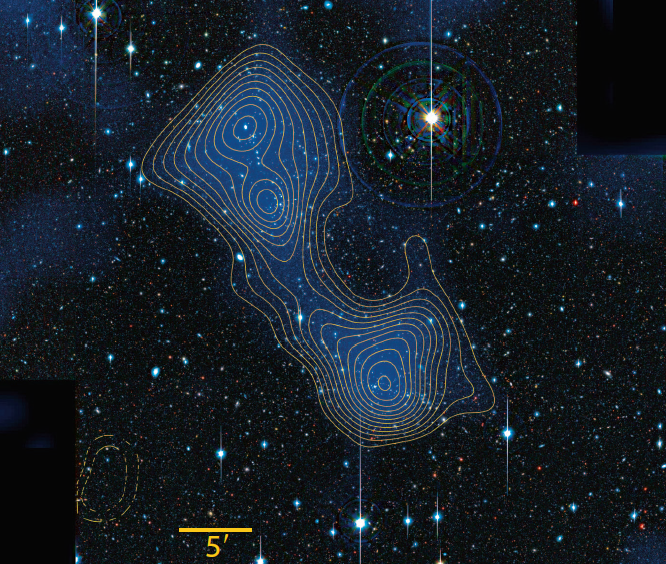Dark matter’s tendrils revealed
July 5, 2012 | Source: Nature News

Dark-matter filaments, such as the one bridging the galaxy clusters Abell 222 and Abell 223, are predicted to contain more than half of all matter in the Universe (credit: Jörg Dietrich, University of Michigan/University Observatory Munich)
A “finger” of the Universe’s dark-matter skeleton, which ultimately dictates where galaxies form, has been observed for the first time.
Researchers have directly detected a slim bridge of dark matter joining two clusters of galaxies, using a technique that could eventually help astrophysicists to understand the structure of the Universe and identify what makes up the mysterious invisible substance known as dark matter.
The presence of dark matter is usually inferred by the way its strong gravity bends light travelling from distant galaxies that lie behind it — distorting their apparent shapes as seen by telescopes on Earth. But it is difficult to observe this “gravitational lensing” by dark matter in filaments because they contain relatively little mass.
By examining X-rays from plasma in a dark-matter filament, observed by the XMM-Newton spacecraft, the team calculated that no more than 9% of the filament’s mass could be made up of hot gas. The team’s computer simulations suggest that roughly another 10% of the mass could be due to visible stars and galaxies. The bulk, therefore, must be dark matter, says Dietrich.
Japan’s Astro-H X-ray space telescope, due to launch in 2014, will be able to characterize the ionization state and temperature of the plasma in the filament, which will help to discriminate between different models of how the structure formed.
Refining the technique could also help to pin down the identity of dark matter — whether it is a cold (slow-moving) particle or a warm (fast-moving) one, like a neutrino — because different particles will clump differently along the filament. The Euclid space mission, due to launch in 2019, will provide more lensing data. “This will complement direct dark-matter searches, for example at the Large Hadron Collider,” says Alexandre Refregier, a cosmologist at ETH Zurich, the Swiss Federal Institute of Technology in Zurich.